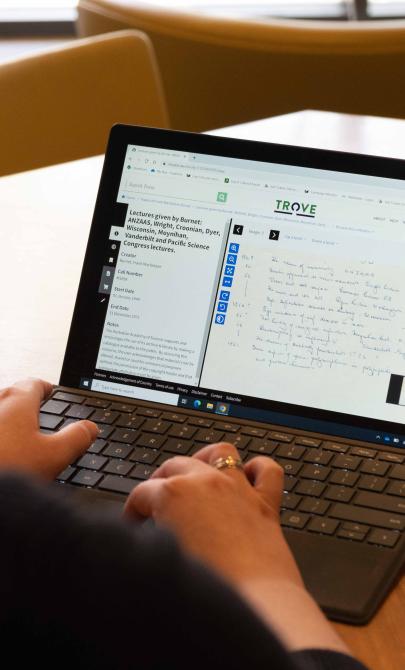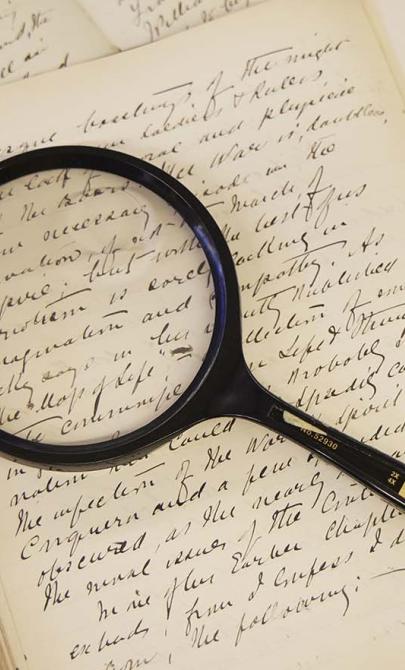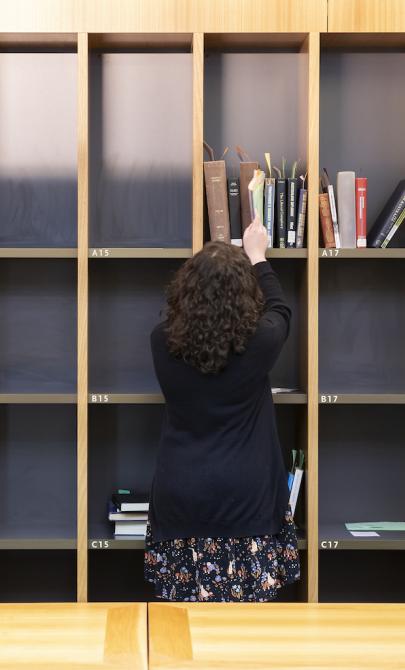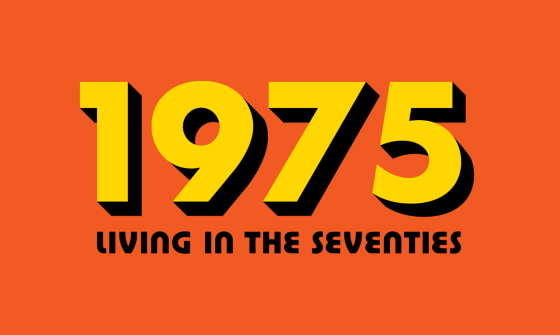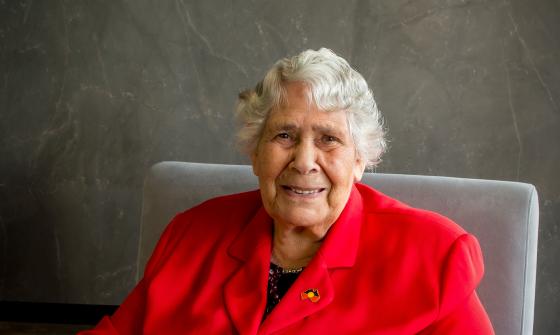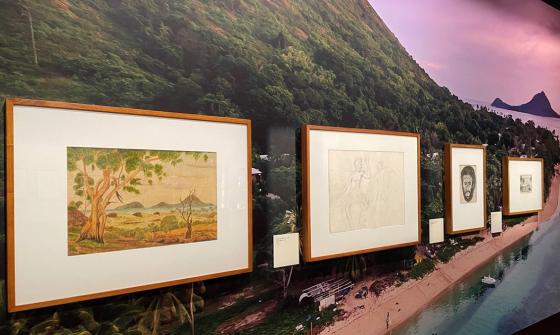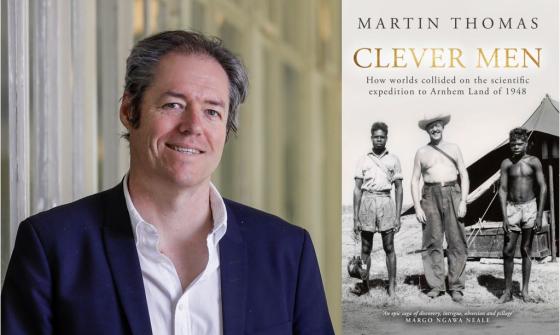Ferguson Collection
Key items in the collection
The Ferguson Collection is the largest and most diverse collection ever acquired by the Library.
It was said to contain about 32,000 items, but this figure almost certainly excludes issues of journals and newspapers or the items within manuscript collections. A short description can do little more than highlight some of the strengths of the collection.
The Ferguson Collection is centred on early books about Australia, New Zealand, and the Pacific. It includes accounts of Pacific voyages in multiple languages, fictional journeys to the South Seas, and works featured in the Bibliography of Australia. Of the approximately 1,500 books published between 1784 and 1830, Ferguson owned about 480—a remarkable number for a private collector. Many of these books are extremely rare, with some being the only known copies in existence. Here are a few examples of these rare editions:
- George Bond, A Brief Account of the Colony of Port Jackson (1803)
- James Burney, A Chronological History of the Discoveries in the South Sea or Pacific Ocean (5 vols, 1803–17)
- The Genuine Life and Trial of George Barrington [1790?]
- The History of New Holland from its Discovery in 1616 to the Present Day (1808)
- John Hawkesworth, An Account of the Voyages Undertaken by the Order of His Present Majesty, for Making Discoveries in the Southern Hemisphere (Dublin, 1773)
- Hamilton Hume, A Brief Statement of Facts in Connexion with an Overland Expedition from Lake George to Port Phillip in 1824 (1855 [only known copy of 24-page edition])
- Phillip Parker King, Narrative of a Survey of the Intertropical and Western Coasts of Australia (2 vols, 1826)
- Parau no Iesu Christ te temaidi no te Atua (1814 [first dated work in Tahitian])
- Mary Ann Parker, A Voyage Round the World in the Gorgon Man of War, Captain John Parker (1795)
- Francisco Pelsaert, Ongelluckige voyagie van het schip Batavia (1648)
- Arthur Phillip, Copies and Extracts of Letters from Governor Phillip (1792)
- Puteshestvie v iuzhnoi polovinie zemnago shara ivokrug onago: uchinennoe v prodolzhenie 1772, 73, 74 i 75 godov… (5 vols, St Petersburg, 1796–1800)
- John Slater, A Description of Sydney, Parramatta, Newcastle, &c. (1819)
- The Voyage of Governor Phillip to Botany Bay (Dublin [1790?])
- James Wallis, An Historical Account of the Colony of New South Wales and its Dependent Settlements: In Illustration of Twelve Views (1821)
- Heinrich Zimmermann, Dernier voyage du Capitaine Cook autour du monde (Berne, 1782).
The Ferguson Collection includes an extensive range of printed ephemera, such as pamphlets, booklets, leaflets, and broadsides. Highlights include:
- 3,010 poetry pamphlets
- 1,044 religious pamphlets
- 3,296 local and church history pamphlets
- 535 biography pamphlets
- 3,010 sociology pamphlets
- 750 World War I pamphlets
The ‘sociology’ category covers diverse topics, including political movements, elections, socialism, communism, fascism, nationalism, civil liberties, women’s rights, economic theory, employment, industrial regulation, trade unions, international trade, social services, public health, and education.
The collection also features Pacific Islands imprints (1840–1966), mainly pamphlets, with strong representation in Maori, Fijian, and the languages of Vanuatu, the Solomon Islands, and Papua New Guinea.
Another unique feature is the cutting books, including 79 volumes compiled by librarian and writer C.H. Bertie.
The Ferguson Collection includes extensive runs of magazines, periodicals, and other serials, along with several sets of law reports and transcripts from the Industrial Commission of New South Wales (1936–51). Examples of periodicals in the collection include:
- Annual Register (1789–1826)
- Australia To-day (1911–29)
- Australian Journal (1866–79)
- Australian Philatelist (1891–1921)
- Bookfellow (1911–15)
- Communist Review (1935–61)
- Hermes (1895–1929)
- Home (1920–42)
- Messenger of the Presbyterian Church of New South Wales (1904-1923)
- Metal Trades Journal (1947–70)
- Le Néo Hébridais (1909–22)
- New South Wales Presbyterian (1926–65)
- United Aborigines Messenger (1931–54)
- Wesleyan Chronicle (1865–74)
- Wesleyan Methodist Magazine (1822–91).
The collection is also particularly strong in newspapers, such as:
- Empire (1852–69)
- Common Cause (1921–54)
- Direct Action (1914–16)
- International Socialist (1908–20)
- One Big Union Herald (1918–25)
- Revolutionary Socialist (1919–22).
The Ferguson Collection includes 415 manuscripts or manuscript collections, making it the largest within the Manuscripts Collection. These documents, dating from 1772 to around 1950, cover a wide range of materials, such as ships' logs, letters, diaries, literary manuscripts, lectures, vocabularies, petitions, title deeds, land grants, indentures, wills, ledgers, local histories, memoirs, cutting books, and currency. While most relate to Australia, particularly New South Wales in the nineteenth century, the collection also includes material from Papua New Guinea, New Zealand, the New Hebrides, Tonga, and other Pacific Islands. Notably, it features papers related to the New Australia settlement in Paraguay, including works by William Lane and issues of Cosme Monthly (1894–96).
One of the standout items is the journal of James Burney, a midshipman on HMS Adventure during Cook's second Pacific voyage (1772–73). The collection is rich in ships' logs, journals by naval officers, and shipboard diaries from emigrants and travellers. Notable examples include:
- The log of Lord Byron on HMS Blonde in the Pacific (1824–26)
- Journals of Phillip Parker King on HMS Adventure in South American waters (1826–30)
- The log of Samuel Swain on the whaling ship Vigilant (1831–35)
- The diary of emigrant S.E. Roberts from his 1848 voyage to South Australia.
The collection also has extensive records on nineteenth-century New South Wales, such as:
- Minute books and records of the Wesleyan Missionary Society in New South Wales (1817–74)
- Papers of Reverend Samuel Marsden and families like Simeon Lord and Sir John Dowling
- Correspondence of journalist Edward Smith Hall (1815–41)
- The order book of the New South Wales Military Police (1834–41)
- The journal The Collegian (1834–35)
- A letterbook of politician Sir Stuart Donaldson (1835–56)
- Autobiographical notes by zoologist Gerard Krefft.
Ferguson also acquired papers from notable nineteenth-century writers such as Henry Kendall, Charles Harpur, Rolf Boldrewood, James Brunton Stephens, and Victor Daley, and extended the collection into the twentieth century with manuscripts by Christopher Brennan, Roderic Quinn, Mary Grant Bruce, and Seaforth Mackenzie.
Other significant manuscripts include Tasmanian convict documents, diaries and papers of John Pascoe Fawkner, a diary of convict John Ward from Norfolk Island (1841–42), letterbooks of Reverend F.A. Hagenauer (1865–85), correspondence of economist William Hearn (1862–86), papers of journalist R.S. Ross (1907–27), and letters of actress Nellie Stewart (1924–31).
The collection also contains Maori documents, vocabularies, and grammars of Pacific Island languages, as well as letters and papers from Presbyterian missionaries, particularly those in the New Hebrides.
The Ferguson Collection includes around 1,000 maps and plans, both published and unpublished, with the majority being cadastral plans of New South Wales. These maps, dating from 1830 to 1920, cover counties, towns, villages, parishes, estates, land grants, and building allotments. Many were published by the New South Wales Surveyor General’s Department, while others were created by private surveyors. There are fewer plans for other states, with Tasmania being the most well-represented, including maps produced by the Van Diemen’s Land Company (1827–31).
The collection also contains a small number of general maps of Australia, Papua New Guinea, New Zealand, and the New Hebrides, as well as charts of ports, maps of railways, goldfields, exploration routes, and local government areas. The growth of Sydney is well documented, with the earliest map in the collection (F306) being a survey of settlement in New South Wales, annotated by Arthur Phillip on 2 December 1792.
In 1920–23, Ferguson acquired a remarkable collection of around 7,000 real estate sale plans from W.H. Pritchard, a real estate agent. These plans, mostly poster-sized and often in colour, provide a detailed record of the growth of Sydney’s suburbs, as well as some country towns and cities like Katoomba, Blackheath, Gosford, Newcastle, Moss Vale, Bowral, Dalgety, and Wollongong.
Music is the smallest part of the Ferguson Collection, consisting of 8 albums and around 210 sheet music items, mostly published in Australia or written by Australians. The collection includes nineteenth-century salon songs, patriotic songs, anthems, waltzes, quadrilles, polkas, and other piano pieces. The largest group is the works of Isaac Nathan, with songs and compositions published between 1815 and 1864.
Ferguson was not an active art collector, but he did acquire a small collection of paintings and drawings. The collection includes 28 items, such as five pencil and wash sketches of Sydney by George French Angas (1852–53), a watercolour of Mount Wingen by Conrad Martens (1865), and a watercolour of the SS Coonabarabya by Frederick Garling (1866). The most notable item is a sketchbook once attributed to Sophia Campbell but actually created by her brother-in-law, Charles Edward Close (1790–1866). Close was a skilled sketcher, watercolourist, and army engineer based in Morpeth, NSW. His Sketchbook of scenes of Sydney, Broken Bay, Newcastle and region, New South Wales (1817–40) meticulously records coastal scenery, buildings, and people in these areas.
In contrast, Ferguson actively collected engravings, lithographs, and other prints documenting Australia, New Zealand, and the Pacific. The collection of 750 prints includes works by William Hodges and John Webber from Cook's voyages, as well as artists from French voyages such as Nicolas Petit, Jacques Arago, Alphonse Pellion, and Louis de Sainson. The largest group of prints features leading nineteenth-century artists like Joseph Lycett, Augustus Earle, John Skinner Prout, S.T. Gill, Eugene von Guerard, Ludwig Becker, and Conrad Martens. The collection also includes portraits of public figures in Britain and Australia, along with city panoramas, streetscapes, and bush scenes, many from illustrated newspapers.
Additionally, the collection contains 25 photograph albums and hundreds of loose photographs, primarily from the late nineteenth and early twentieth centuries. The main focus is Sydney and its surroundings, including panoramas and images of streets, buildings, and the harbour. Other cities featured are Newcastle, Melbourne, Hobart, and Rockhampton. The collection also includes numerous photographs of the New Hebrides (Vanuatu), showcasing the landscape, villages, ceremonies, planters' houses, and the recruitment of labourers. There are also photographs from New Zealand, the Solomon Islands, New Caledonia, Papua New Guinea, Fiji, Tonga, Samoa, and Hawaii. Notable photographers include Anson Brothers (Hobart), Alfred Burton (Dunedin), Charles Kerry (Sydney), Henry King (Sydney), J.W. Lindt (Melbourne), and Charles Nettleton (Melbourne).
The papers of Ferguson are extensive, filling 106 boxes, though very few documents survive from before 1918. From that point onward, the collection includes a large amount of correspondence with booksellers, collectors, and librarians, primarily related to the Bibliography of Australia and Ferguson’s collecting activities. There is also a small amount of family correspondence. Other papers in the collection include invoices, financial records, drafts of articles and other writings, cutting books, loose cuttings, photographs, printed ephemera, and drafts and proofs of the Bibliography of Australia.
About Sir John Alexander Ferguson
Early life and education
Sir John Alexander Ferguson (1881–1969), who was the son of a Presbyterian minister, was born in Invercargill, New Zealand. His family moved to Sydney in 1894 and he was educated at the William Street Superior School and the University of Sydney. He was admitted to the Sydney Bar in 1905. He developed an active practice in most branches of the law, but gradually he came to specialise in industrial law. He appeared in appeal cases in the Supreme Court of New South Wales and the High Court and chaired a number of wages boards. In 1934 he became the first lecturer in industrial law at Sydney University and in the following year was appointed a judge of the New South Wales Industrial Commission. He retired in 1951.
Passions for Australian history and biography
As a young man, Ferguson became deeply interested in Australian history He was twice president of the Royal Australian Historical Society. His interest in history was closely linked to his passion for bibliography and book collecting. In 1917–18 he published A Bibliography of the New Hebrides and in the following years he embarked on bibliographies of imaginary voyages, works ascribed to George Barrington, the Pacific Islands, Australia in World War I, John Dunmore Lang, Queensland and the Australian Aboriginal people. In the 1920s he started work on his magnum opus, The Bibliography of Australia. The first volume, covering the years 1784–1830, was published in 1941 and the seventh volume, bringing the work up to 1900, appeared shortly after his death in 1969. He was knighted in 1961 in recognition of his achievements as a bibliographer.
Building the collection
Ferguson began collecting books at an early age and over the years he extended his collecting to manuscripts, maps, printed ephemera, newspapers, paintings, drawings, prints and photographs. He was encouraged by his father-in-law, the publisher and bookseller George Robertson, and he enlisted the help of many acquaintances in the Presbyterian Church. For instance, ministers in country towns often supplied him with local and church histories and obscure pamphlets, while missionaries in the Pacific Islands were the source of many of the publications in his formidable Pacific collection. Much of his early Australiana was purchased from antiquarian booksellers in Britain and North America, most notably Francis Edwards in London. The great period of Ferguson’s collecting was the 1920s when his legal practice was flourishing, he had acquired a large house, and he had the energy and resources to deal simultaneously with an extraordinary range of booksellers, collectors, librarians, writers, editors and printers, as well as the descendants of notable figures in Australian history.
Ferguson attempted to collect Australian books and pamphlets generally, at least up to 1900, but he recognised that in the twentieth century collectors needed to specialise. He identified 30 fields of collecting, of which the following are the most substantial:
- Australian and New Zealand poetry
- sociology and economics
- church history (especially the Presbyterian Church)
- publications in the vernacular languages of the Pacific Islands
- publications of Angus & Robertson
- publications relating to Australia at war
- Australian local histories.
Other fields included Pacific Islands history, New Zealand history, convicts and transportation, history of Federation, fine art books, bibliography, standard English authors, James Cook, law, general science, R.L. Stevenson, Scottish material and biography.
Later years
In later years, he was faced with a lower salary, the needs of a young family and rising prices for early Australiana, while the demands of the Bibliography reduced the time that he could spend on his collection. Nevertheless, he continued to collect books, and occasionally other materials, until the last years of his life.
Background to the collection
Ferguson first visited the Commonwealth Parliamentary Library in 1910, and after World War I, he regularly exchanged duplicates and verified bibliographical details with the Library. In 1937, he suggested creating the Ferguson Collection within the Library, which was accepted. He began transferring his sociological pamphlets in 1938, followed by newspapers, World War I journals, maps, and prints. In 1954, the Library purchased his poetry collection, and from then on, his other items were sold rather than donated. After his death in 1970, the Library bought the remaining collection, including items on voyages, early Australiana, and manuscripts, from his family.
Books, ephemera and serials
The books, pamphlets and periodicals in the Ferguson Collection are kept together as a formed collection within the Australian Collection. They have been catalogued individually and are arranged in a number of sequences. For instance, items covered in the Bibliography of Australia are shelved by the bibliography number, others have been given Dewey numbers, and others form a numerical sequence (7782 items). The poetry, biography, religion, sociology and local history pamphlets each form a separate sequence. On the other hand, the Pacific Island pamphlets have Dewey numbers and the World War I and World War II pamphlets are shelved in the numerical sequence. The abbreviations JAF, FC or FERG in the call numbers or catalogue entries denote that the items are part of the Ferguson Collection. Many of the pamphlet runs, such as the Ferguson Bibliography Pamphlets and the World War I pamphlets, as well as broadsides and other ephemera, have been digitised and are available online.
A small number of pre-1800 non-Australian books, including imaginary voyages, are held in the Rare Books Collection. The call numbers have the prefix RB JAF. The newspapers in the Ferguson Collection have been integrated in the Newspapers Collection.
Manuscripts
The manuscripts are kept together within the Manuscripts Collection at MSS 3201–3624. They have been catalogued individually. A small number, such as the diaries of Rolf Boldrewood, have been microfilmed. The journal of James Burney was published by the Library under the title With Captain James Cook in the Antarctic and Pacific: The Private Journal of James Burney, Second Lieutenant of the Adventure on Cook’s Second Voyage, 1772–1773 (1975). It was edited by Beverley Hooper.
The personal papers of Ferguson are also held in the Manuscripts Collection. There is a partial listing, but they have not yet been fully arranged or listed.
Maps
The maps and plans are kept together as a formed collection within the Maps Collection. They have been catalogued individually and the great majority have been digitised and are available online. The call numbers of the maps have the prefix MAP F. The majority of the sale plans are arranged alphabetically by place and are bound in volumes; they are also accessible on microfiche. The call numbers of the loose sale plans, which number about 2800, contain the abbreviation LFSP.
Music
The music in the Ferguson Collection is kept together within the Music Collection. It occupies nine boxes. The items have been catalogued and the call numbers have the prefix MUS N JAF. Many of the Isaac Nathan scores have been digitised.
Pictures
The paintings, drawings and prints are held in the Pictures Collection at various locations. Only a portion of them have been catalogued and the catalogue entries often do not refer to the Ferguson Collection. A small number have been digitised, including the Sophia Campbell sketchbook. The photographs are also held in the Pictures Collection. The 25 albums are not kept together but are integrated in the main run of photograph albums. The majority of loose photographs are kept together as a collection, while the others are filed under geographical names and other subject headings.
This guide was prepared using these references:
- D.W.A. Baker, Bibliographer and Collector: The Legacy of Sir John Ferguson, National Library of Australia News, vol. 9 (6), March 1999, pp. 13–15.
- R. Else-Mitchell, Ferguson, Sir John Alexander (1881–1969), Australian Dictionary of Biography Online
- Pauline Fanning, The Ferguson Collection, Australian Library Journal, vol. 19 (10), November 1969, pp. 341–9.
- James Ferguson, John Alexander Ferguson: preserving our past, inspiring our future, National Library of Australia, Canberra, 2011.
- Graeme Powell, The Great Bookmen: E.A. Petherick and J.A. Ferguson, in Peter Cochrane (ed.), Remarkable Occurrences: The National Library of Australia’s First 100 Years 1901–2001, National Library of Australia, Canberra, 2001, pp. 41–59.
- G.D. Richardson, The Instruction and Good of His Country: Sir John Ferguson, Libraries, and the Historical Record, John Ferguson, Sydney, 1977.
